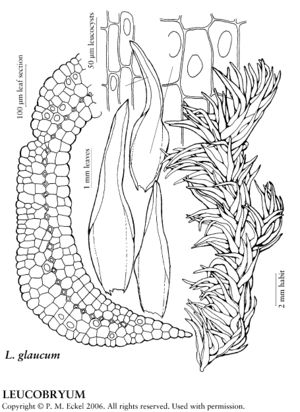Plants in small to large cushions, white to pale green, glaucous, grayish or pale brown. Stems erect, branching, central strand absent or poorly developed. Leaves thick, consisting mostly of an expanded costa, distal part of leaf (limb) linear, ligulate or lanceolate, ± tubulose, spreading from a narrow base (sheath); costa consisting of 2 to several layers of enlarged empty, hyaline, thin-walled, porose cells (leucocysts) enclosing a central layer of small, green cells (chlorocysts); unistratose lamina restricted to leaf base, consisting of very narrow, delicate, hyaline, quadrate to oblong or linear cells. Sexual condition dioicous, pseudautoicous, or autoicous. Seta terminal, straight. Capsule erect to inclined, symmetric or asymmetric, often strumose; operculum long-rostrate, often longer than urn; annulus present or absent; peristome teeth 8–16, entire or divided 1/2 their length, articulate. Calyptra cucullate or mitrate, smooth, rarely fringed at base. Spores spherical.
Distribution
Worldwide except Antarctica in temperate and tropical areas.
Discussion
Genera 8, species ca. 155 (1 genus, 2 species in the flora).
Species of Leucobryaceae are characterized by plants with thick, whitish leaves consisting mostly of expanded costa and narrow basal lamina. The actual number of genera in this family is uncertain. Current attributions range from one (A. Eddy 1988+, vol. 2) to four (D. H. Vitt 1982) to eight (H. Robinson 1985). Because of its peculiar peristome, Octoblepharum is placed in the Octoblepharaceae by Eddy and in the Leucophanaceae by W. D. Reese (pers. comm.). The Leucobryaceae have been sometimes included in the Dicranaceae because of similar costal modifications in Brothera, Campylopus, and Paraleucobryum and a peristome structure identical with that of Dicranum (M. R. Crosby and R. E. Magill 1977). Robinson suggested that in large part the characteristic pale color of Leucobryum is caused by air bubbles in the leucocysts, and the presence of air in the leaf is assumed characteristic of the Leucobryaceae. Furthermore, he concluded that “such bubbles are necessary for the function of the chlorocysts, which are remote from the surface of the leaf, and which could not properly exchange gases if the leucocysts were all filled with water.”
Selected References
Lower Taxa
Illustrations
| Family ⠉ | Taxon | Illustrator ⠉ | |
|---|---|---|---|
 | Leucobryaceae | Leucobryum glaucum | Patricia M. Eckel |